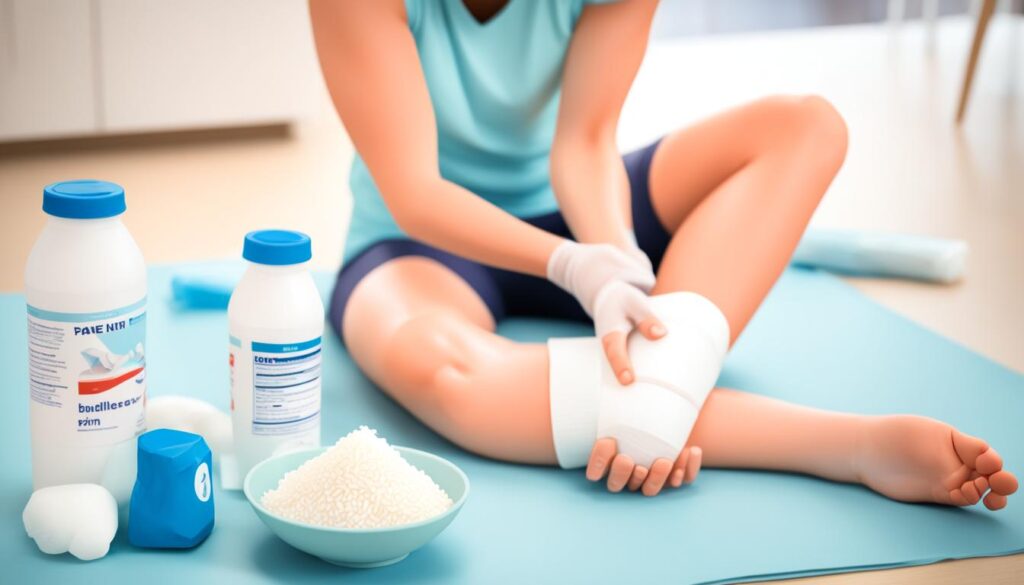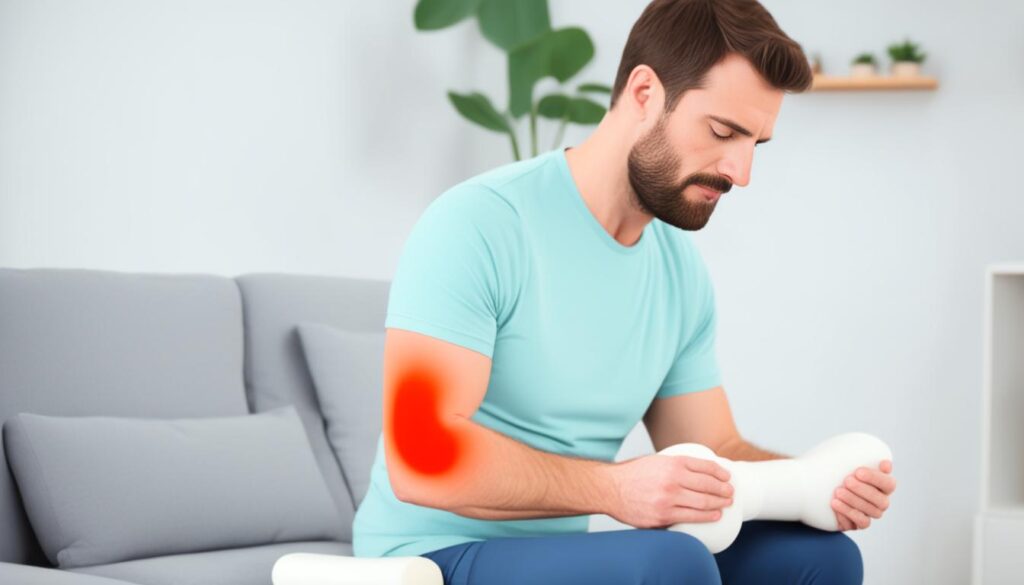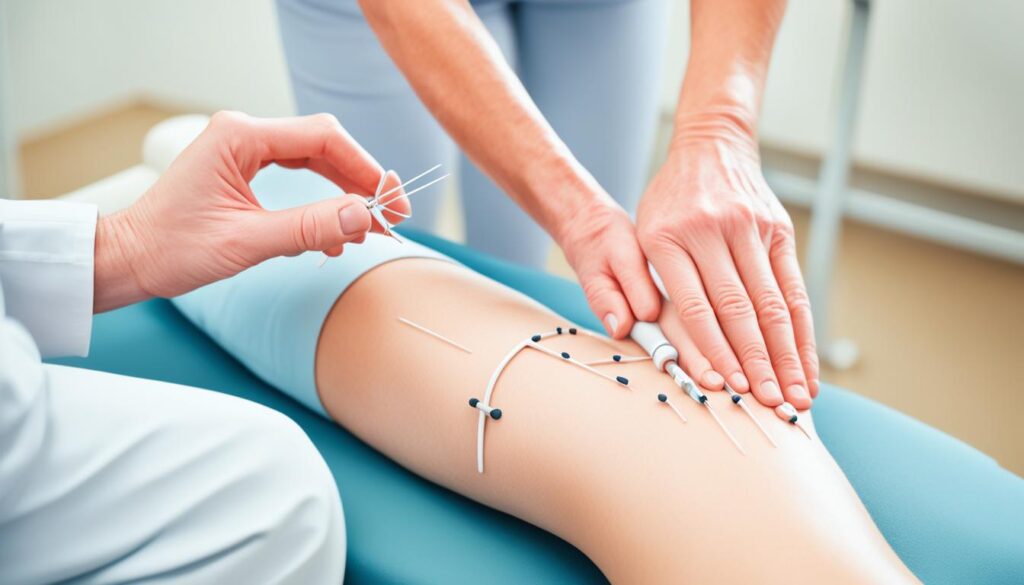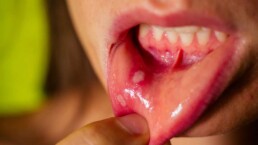Feeling frustrated due to knee pain is never fun. You don’t have to just take medicine for relief. Many at-home treatments and natural cures can make your knee feel better. They also help your joints in general. This includes steps like the RICE method, easy exercises, and some herbal supplements. This article will guide you on how to ease knee pain from home.
Table of Contents
ToggleKnee pain can happen because of many reasons. It could be from an injury, arthritis, or just using your knee too much. But, you can do a lot to feel better and help your knee heal, no matter what’s causing the pain. This guide will teach you how, whether it’s a new injury or a long-term issue. You’ll learn to take charge of your knee health and get the relief you’re looking for.
Assessing Your Knee Pain
Knee pain can worry us, but many cases get better at home. The trick is to check how bad your pain is. And know when to get help if you need it. This way, you can pick the right thing to do.
When to Seek Medical Attention
For light to middle knee pain, home fixes can work. But for big signs, go see your doctor. Here are red flags that mean get help fast:
- Severe, unrelenting pain
- Significant swelling or deformity of the knee
- Inability to bear weight on the affected leg
- Locking or catching sensations in the knee joint
- Instability or a feeling that the knee may “give out”
- Persistent pain that doesn’t improve with rest and self-care
These signals might show a big problem, like a tear or a break. A doctor will check you well. They might do exams or tests to find what’s wrong. Then, they’ll make a plan to help you heal.
If you know you have other health issues, like diabetes, it’s good to get checked. These can slow down your knee’s recovery. Your doctor will know how to treat you best. They’ll make sure you get the care that fits your special needs.
RICE Method for Strains and Sprains
If you hurt your knee, try the RICE method. This stands for Rest, Ice, Compression, Elevation. It helps with pain and swelling. Dr. Gabe Mirkin came up with the RICE method in 1978. It’s good for small injuries like sprains, jammed fingers, and overuse injuries.
First, sit down and let your knee rest. Put an ice pack on it for 15-20 minutes a few times a day. This helps lower the swelling. Then, wrap your knee with a bandage to keep the swelling down. Make sure to keep the leg up. This helps with blood flow.
Some new studies say too much ice and rest might not be good for you. They think it might slow the body’s way of healing. Now, they say you should only use ice for 10 minutes every 1-2 hours in the first 6 hours after you get hurt.
Keep following the RICE steps for 1-3 days. After that, start moving your knee more. But not all injuries should be treated this way. If you think your injury might be serious, like a broken bone, see a doctor right away.

Along with RICE, there are other ways to treat knee injuries. You could try PEACE, MICE, MEAT, or LOVE. These methods are also good for knee pain.
You can also take ibuprofen or acetaminophen for the pain. But, it’s best to ask a doctor first. They might say not to use certain drugs to help your knee heal.
It’s also smart to prevent knee injuries. Wear the right shoes and take breaks when you’re active. Keeping your body strong and flexible can lower your chance of hurting your knee.
Tai Chi for Knee Pain Relief
Do you suffer from knee pain, perhaps due to osteoarthritis? If so, tai chi may be perfect for you. This ancient Chinese practice is gentle and low-impact. It combines flowing moves, deep breathing, and focusing your mind. This helps improve your balance, flexibility, and how your joints work.
Studies show tai chi is great for knee osteoarthritis. Adding it to your daily life can help a lot. It reduces pain, makes you more mobile, and boosts your life quality.
Benefits of Tai Chi for Osteoarthritis
Tai chi helps with knee osteoarthritis in many ways:
- Less knee pain and stiffness
- Better balance and coordination
- Stronger muscles and more flexible
- More movement in the knee joints
- Less chance of falling, making daily life safer
- Using less pain medicine
- Improving how you feel physically and mentally
The American College of Rheumatology and Arthritis Foundation gave tai chi their thumbs up. They see it as a great, safe treatment for knee osteoarthritis. Just by adding this gentle and mindful exercise to your day, you can help manage knee pain. And you can make your life better.
Tai chi is for everyone, old or young, fit or needing a bit more help. If you’re new or experienced, there are ways to adjust the moves. This makes it fit your own needs and abilities. Be sure to find a certified tai chi teacher. They’ll show you the correct ways and keep you safe.
The Importance of Exercise
Moving often is key to keeping knees happy and joints strong. While taking it easy can make knees feel better at first, it might cause them to get stiff later. Doing gentle activities like walking, riding a bike, swimming, and tai chi is great. They make knee muscles strong and keep joints flexible without too much pressure.
A study by the Arthritis Foundation found that exercise is top-notch for fuzzy knees. And the U.S. Department of Health and Human Services backs this up. Their tips say exercise does wonders for your health, especially your joints.
Seeing a specialist can mean getting an exercise plan just for you. They might suggest exercises like:
- Clamshells: Aim for 15-20 reps on each side.
- Straight-Leg Lifts: Start slow, then add more over time.
- Sit/Stands: Do three sets of this one.
- Step-Ups: Start with a 6-8 inch step, switch sides often.
- Glute Bridges: Hold it a bit and make sure you do it right.
Add these moves to your daily routine and feel your knees get stronger. Start at a comfy pace and build up. Push yourself a bit more as you get used to it. And don’t forget to pay attention to how your body feels.
Working out is super important for keeping knees in tip-top shape. Doing regular, gentle exercises can make knee pain better, keep joints healthy, and boost how good you feel. Talk to a doctor for a plan that fits you and your knees just right.
Weight Management for Knee Pain
Extra weight puts more pressure on your knees. This makes pain and swelling worse. The Arthritis Foundation says for each extra 10 pounds, your knees feel 15 to 50 pounds heavier. To feel better, lose weight with a good diet and exercise.
If you’re at a healthy weight, you’re less likely to have knee problems. For those with serious obesity, knee issues are more common. For every pound you lose, it’s like 4 pounds less on your knee. The American College of Rheumatology and Arthritis Foundation agree, losing 5 percent of your weight helps.
Getting help from a doctor or nutritionist is a great idea. They can guide you on eating well and working out. This focuses on losing weight to ease knee pain. They’ll suggest activities like walking, cycling, and yoga.
They may advise aiming to lose 10 percent of your weight. This targets getting to a healthy BMI. This not only helps your knees but also fights other health issues. These include diabetes, high blood pressure, and heart disease.
Taking action on your weight can really help your knees. It’s about feeling better and living healthier. So, start by losing some weight to help your knees and your overall life.
Hot and Cold Therapy
Using hot and cold treatment helps with knee pain. Warm treatments relax muscles and get blood moving. This makes the knee less stiff and sore. Cold therapy lowers swelling and numbs pain.
Tips for Applying Heat and Cold
Put heat on your knee for up to 20 minutes at a time. It boosts blood flow and makes your joint more flexible. For cold, use it for 15-20 minutes, a few times daily. It cuts down on swelling and eases the ache.
Never put ice directly on your skin. It can harm your skin. Always test the heat or cold on your wrist first. It shouldn’t be too extreme. Switching between hot and cold is the best way. It lets your body smoothly handle the temperature changes.
- Use a heating pad, warm bath, or hot compress for up to 20 minutes at a time to relax muscles and improve blood flow.
- Apply ice packs or cold compresses for 15-20 minutes, several times a day, to reduce inflammation and numb pain.
- Avoid applying ice directly to the skin and check the temperature before use to prevent burns or frostbite.
- Alternate between hot and cold therapy, allowing your body to adjust to the temperature changes.
Adding heat and cold therapy to your routine helps ease knee pain. Always talk to a doctor if your pain doesn’t get better.
Herbal Remedies and Ointments
Seeking natural ways to ease knee pain? Herbal remedies and ointments can help a bit. Some plant-based ingredients work as well as pain creams you buy. Cinnamon, ginger, mastic, and sesame oil in salves can reduce knee pain.
Willow bark extract is a promising herbal remedy. It has a compound like aspirin, good for inflammation and pain. It’s good to be careful with willow bark and check with a doctor first. Always consult a professional before trying new herbs for knee pain.
Ginger and turmeric are also good for joint pain. A 2017 study showed ginger works as well as ibuprofen for pain. A 2021 review said turmeric might help reduce pain like NSAIDs.
Lavender oil lessened pain in a 2023 study. Rosemary, peppermint, and eucalyptus oils can also help. They make life easier for people with arthritis.
Remember, talk to a healthcare professional before using these remedies for your knee pain. They can check what’s causing your pain and suggest the best treatments.
Willow Bark for Joint Pain
Do you have knee pain or other joint problems? Willow bark could help you feel better. For centuries, people have used it to ease different kinds of pain, like from osteoarthritis and rheumatoid arthritis.
There’s a special thing in willow bark called salicin. It’s a bit like what’s in aspirin. This can help lower swelling and make your joints hurt less. But, we’re still not 100% sure it works for everyone with joint pain.
Precautions with Willow Bark Use
Be careful with willow bark, even though it might help. It might not mix well with some drugs, like for blood pressure. If you’ve had tummy, diabetes, liver issues, or are allergic to aspirin, skip this.
Always talk to a doctor before trying willow bark. They can tell you how much to take, without messing up your other meds or illnesses.
Watch out for side effects like an upset tummy, nausea, or headaches. Stop using it if you feel bad and get help.
In short, willow bark could ease your joint pain. But talk to your doctor first. They’ll make sure you use it safely, which is very important.
Ginger Extract for Arthritis Pain
Do you have knee pain from arthritis? Ginger might help you feel better. You can find ginger in many forms like supplements, tea, or as a spice in food. Research shows ginger can help with knee pain from arthritis.
A study in 2015 discovered that ginger reduced pain and made movement better in people with arthritis. If you use ginger with your current treatments, it could help even more. This could mean less knee pain for you.
Many studies have looked at how effective ginger is for osteoarthritis:
- In 2000, a study found that ginger was as good as ibuprofen for early arthritis pain.
- A study in 2016 found that ginger and echinacea reduced knee surgery pain and swelling.
- In 2001, ginger helped people with knee osteoarthritis feel less pain when standing or walking.
- A rat study in 2002 showed ginger might lessen rheumatoid arthritis pain by reducing swelling.
While the studies sound good, the strength of ginger supplements can vary. The Arthritis Foundation says you should not take more than 2 grams of ginger a day, or drink up to 4 cups of tea. They warn that not all ginger products are good quality, since the FDA doesn’t watch over supplements.
If you want to try ginger for your arthritis pain, talk to your doctor first. Adding ginger to your meals or using ginger cream could be a good idea. It is a natural way to help your treatment.
Knee Pain Treatment at Home
Knee pain is a bother, but you can treat it at home. Using simple steps and changes can help a lot. These ways will give comfort and stop the problem from getting worse.
The RICE method works well for strains and sprains. It includes Rest, Ice, Compression, and Elevation. This helps reduce swelling, ease pain, and speed up healing. You can also take ibuprofen or acetaminophen for pain relief.
Exercising daily with stretches can make your knee stronger. This helps the joint work properly. Tai chi can be very good for your knees. It makes them more flexible and lowers pain.
Maintaining a good weight is important for knee health. Extra weight makes pain worse. Eating right and moving more can help keep your weight in check.
Hot and cold packs are good for knee pain too. Use a heating pad to get blood moving or take a warm bath. Ice packs can cool down swelling and make pain less.
Doing these treatments at home is great, but remember to get help if the pain is very bad or lasts a long time. Serious signs like big swelling or a weird shape need a doctor. They will know the best way to help.

By using the RICE method, exercising gently, managing weight, and hot or cold therapy, you can help your knee pain. Always talk to a doctor if you’re not sure what to do. Sharing your worries with a healthcare professional is a smart move.
Massage for Knee Pain Relief
Knee pain can be tough, but massage might help. It works by boosting blood flow, easing muscle tightness, and calming you down. This can all help make your knees feel better.
The American Massage Therapy Association has tips for knee pain. They suggest gentle techniques like tapping and sliding your hand over your knee to soothe it. Pressing fingers gently into the knee can also help.
While not a cure, massages may ease knee osteoarthritis symptoms. A study found that self-massage made a real difference in pain and movement for some. This means there’s a chance it could work for you too.
With over 9 million people in the U.S. having knee osteoarthritis, new ways to handle the pain are needed. As more people get older, we expect this number to grow. So, self-massage is becoming quite important for many.
Some oils, like peppermint and eucalyptus, can make knee massages even better. They might reduce knee pain, swelling, and loosen joints. This makes moving your knees easier.
So, if knee pain’s got you down, try adding massages to your routine. Make sure to talk to a doctor if your pain doesn’t get better.
Aromatherapy and Essential Oils
If you’re looking for natural ways to cope with knee pain, aromatherapy and essential oils might help. Studies show that some essential oils and mixtures could ease knee aches, especially for people with knee osteoarthritis.
Potential Benefits of Aromatherapy
Some research claims that putting oils like ginger, orange, and cinnamon on your skin might lower pain. It can also help people with bad knees move better. While we need more research, trying aromatherapy or using these oils might help handle your knee issues.
One small study had good news for older folks. They used black cumin oil on their knees. After three weeks, they felt better than the ones just using a pain medicine. People who smelled eucalyptus oil after a knee surgery also had less pain and calm blood pressure.
A study on arthritis in rats showed promise too. A mix of frankincense and myrrh oils helped their joints. People with sore knees felt less pain a month after a ginger oil massage. This made them move around better.
Remember, always talk to a doctor before trying new treatments. They can point out how to use oils safely. They’ll also check for any reasons you shouldn’t use them.

Protection, Rest, Ice, Compression, and Elevation (PRICE)
The PRICE method is great for dealing with knee sprains and strains at home. It stands for Protection, Rest, Ice, Compression, and Elevation. These steps can lower knee pain and boost healing.
First is to protect your knee. Use a brace or splint to stop more harm. Rest helps your body heal.
Use ice on your knee for 15-20 minutes many times a day. It cuts down on swelling and pain. Compression with a bandage helps, too.
Keep your leg above your heart to reduce swelling. The PRICE method lets you take care of knee injuries at home. It helps you recover faster.
Start the PRICE method right after you hurt your knee for best results. If things don’t get better, see a doctor. They can help prevent big problems later on.
Acupuncture for Knee Osteoarthritis
Dealing with knee pain from osteoarthritis? Think about trying acupuncture. It’s a Chinese medicine way that might help with knee osteoararthritis.
A 2017 study showed real acupuncture helped more than fake or just learning. People had less pain and better function. The American College of Rheumatology and the Arthritis Foundation say acupuncture could help knee arthritis pain.
Studies suggest acupuncture together with Chinese herbs works well. In a big look at 33 trials with almost 4,000 people, the mix improved a lot. The combo had odds of 5.41 for a good effect.
What did the studies find acupuncture could do?
- It lowered pain according to the VAS scale.
- It made people function better according to WOMAC scores.
- Knee function got a lot better by the Lysholm scores.
But remember, acupuncture may not always help enough over time. There might also be soreness, bruises, and pain after the treatment. You need to keep these in mind.
If you’re looking into acupuncture for knee osteoarthritis, talk to your doctor first. They can tell if it’s right for you. They’ll also make sure it’s safe for you.

Tai Chi: A Recommended Exercise
If you have knee osteoarthritis, tai chi might help you feel better. Many studies show the benefits of tai chi for knee OA. One study with 204 people found that those doing tai chi for a year improved as much or more than those in physical therapy.
Tai chi makes your knee more flexible, your balance better, and your muscles stronger. It also makes you feel emotionally and mentally better, reducing depression and upping your life quality. This slow and smooth Chinese exercise could be a great help for your knees.
A study published in Restorative Neurology showed intensive yoga for eight weeks helped people with arthritis. It made them physically and mentally better, and less depressed. Tai chi also helps with hip and knee OA, easing pain like aerobic exercises do.
If you think tai chi is for you, find a good teacher. They will show you the right way to do it safely. Doing tai chi regularly can help your knees and make you feel better all around.
But before starting any new exercise, talk to your doctor. This is especially important if you have health problems or are worried. They will tell you how to best use tai chi for your knees and your health.
Conclusion
Knee pain can change how you live every day. But, the great news is many cases can be handled at home. This includes using the RICE method, doing light exercises, and watching your weight.
Hot and cold therapy, plus a few herbal or aromatherapy treatments, might also help. This is especially true for mild to moderate knee pain. Remember, if your pain is really bad or won’t go away, or if you see other worrying signs, it’s time to see a doctor.
Taking care of your knees means you can help yourself with pain. This is good for your knees and your whole body. Knowing the best home treatments for knee pain can make a big difference. It can help you move better and enjoy things you like to do again.
FAQ
When should I seek medical attention for knee pain?
If your knee pain is bad, has swelling or looks odd, get help. Also, see a doctor if it stays bad for more than a few days. It could be a sign of a serious problem that needs treatment.
How can the RICE method help manage knee pain?
Resting, icing, compressing, and elevating (RICE) reduces knee pain and swelling. It means resting your knee. Then, ice it. Afterwards, put a bandage on it and keep it up high.
What are the benefits of practicing tai chi for knee osteoarthritis?
Tai chi is a good way to help knee pain from osteoarthritis. It makes your balance, flexibility, and movement better. It also helps lower stress.
How can weight management help with knee pain?
Being overweight can hurt your knees more. Moving and eating right helps you lose weight. This takes off the pressure from your knees, making them feel better.
What are the benefits of using hot and cold therapy for knee pain?
Hot and cold packs are great for knee pain. Heat helps your muscles relax and brings more blood. Cold makes the swelling go down and stops the pain.
Can herbal remedies and ointments help with knee pain?
Some plants can help knee pain, like cinnamon and ginger. But, make sure to talk to a doctor before using them. Not everything works for everyone.
What are the potential benefits of using willow bark for joint pain?
Willow bark is like aspirin and might make your joints less sore. Check with a doctor first, especially if you have certain health issues. They can tell if it’s safe for you.
How can ginger help with knee arthritis pain?
Ginger, in teas or as pills, might make your knee less achy. It works well with other treatments. Studies say it can reduce pain and make you move easier.
How can massage help alleviate knee pain?
Massaging your knee or getting a massage can help your blood move better. It also makes your muscles less tight and you feel more calm. Not a lot is known, but it could help you feel better.
Can essential oils and aromatherapy help with knee pain?
Some oils might make your knee hurt less. Ginger, orange, and others mixed in oils could help. This is mostly for those with bad knee osteoarthritis, but it could work for you.
What is the PRICE method for managing knee injuries?
Properly managing knee injuries with the PRICE method includes protecting, resting, icing, compressing, and elevating. This method is good for sprains. Protect your knee, rest, ice, wrap it, and keep it up.
How can acupuncture help with knee osteoarthritis pain?
Acupuncture is from China and can help with knee pain. It’s more helpful than fake acupuncture or just learning about it. Many find it makes them hurt less and move better.
What are the benefits of practicing tai chi for knee osteoarthritis?
Tai chi is low-impact exercise that’s great for bad knees. It helps your joints move better and you feel stronger. It also makes you less sad and improves your life.
Source Links

This article is medically reviewed by Dr. Chandril Chugh, Board-Certified Neurologist, providing expert insights and reliable health information.
Dr. Chandril Chugh is a U.S.-trained neurologist with over a decade of experience. Known for his compassionate care, he specializes in treating neurological conditions such as migraines, epilepsy, and Parkinson’s disease. Dr. Chugh is highly regarded for his patient-centered approach and dedication to providing personalized care.








